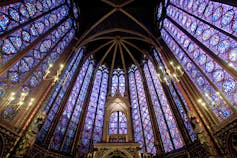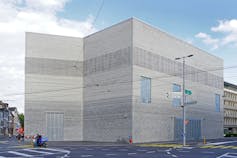Digital media are changing the face of buildings, and urban policy needs to change with them
Looking over the Melbourne skyline in the evening, I can see at least four high-rise building facades containing digital media. They’ve become animated, almost flickering like diamonds. And we see this across the globe: buildings now seem to compete to be the most mind-boggling in appearance.

Architecture has opportunities that it never had before, and urban policy needs to keep up with these developments.
Buildings have always been used to display cultural psyche, norms and values. In ancient Greece, sculptures enveloping facades conveyed stories of heroism. In Gothic religious architecture, delicate decorations conveyed a theological message. And the grandiosity of Baroque architecture aimed to exemplify power, triumph and wealth.
Over time, facades became separated from load-bearing structures. They started acting like independent skins, subject to material, formal and technological experimentation.
Today, architecture often boasts dynamic lighting that can transform physical appearance. The phenomenon is known as media architecture.
Some architects took it as far as turning facades into interactive canvasesfor creative expression. Others made facades display ambient data such as the weather forecast, internal activity or energy consumption.
Media architecture as a selling point
Miniaturisation, improved energy efficiency and increasingly affordable lighting technology have expanded the architectural design palette. As a result, facades turn into interfaces that are endlessly adaptable and responsive.
Architecture can now better respond to sudden requirements and become a platform for creativity. In fast-growing property markets such as China, South Korea and Australia, property developers recognise the value of media architecture. They embrace abstract lighting to enable developments to stand out in external appearance.
Digital media facades now light up the city, enabling buildings to act as dynamic landmarks. And a well-considered luminous building envelope that displays abstract digital visualisations can also make a cultural contribution to the city.
The Melbourne Planning Scheme and the Sydney Guidelines for Public Art allow media architecture as a cultural contribution in new developments. We are provided with new urban perspectives as buildings colour the city. The dynamic lighting can contribute to a sense of safety, provide a creative outlet, or create a shared platform for play.
Thus, building “good” media architecture is a complex design challenge. It requires expertise in architectural design, urban design, interaction design, lighting design, user experience and community engagement.
Planning policy must adapt
Urban policy evaluates the environmental, social and economic merits of new developments. It aims to ensure that architecture delivers a high-quality public realm for current and future generations.
Policy is regularly updated to take account of emergent needs and opportunities. And cities are increasingly proposing policy for media architecture in urban planning schemes. This indicates a growing consensus on its contribution to urban areas.
If done well, media architecture can bring communities together, such as by allowing involvement in the design process and after completion. If not done well, it can highlight an architectural disconnect or social and cultural issues. This can result in disinterest, disapproval and even vandalism.

Good design processes proof media architecture against technical evolution, repurposing and obsolescence. These design requirements should be better represented in policy and decision-making processes.
Such an approach would involve councils in stimulating the uptake of media architecture to activate public space. There is an initial opportunity to align policy on digital media with policy on public open space.

Digital media policy currently focuses on protecting vistas and avoiding visual clutter. Public open space policy is more qualitative and experiential in nature. It states the need for open spaces that enhance liveability, engagement and attractiveness.
Both policies should remain. This is critical. But councils should recognise that media architecture can engage people and improve the appeal of public space at the same time.
What are the key policy issues?
Councils ought to set out specific guidelines on design and decision criteria to promote long-term sustainability and acceptance. These include:
- Types of engagement. How can people interact with media architecture? Who are these people – local citizens or everyone? Is a specific age group addressed? Is the public involved in the design process? Is there a cultural program that media architecture should align with, such as White Night or Vivid?
- Universal comprehensibility of displayed text, images or symbols across cultural norms and values. Should such information undergo moderation? How is this process installed, maintained and reviewed? Who takes part in moderation?
- Prevention of architectural and urban conflict. How is light intrusion in people’s private spaces mitigated? How do the digital media contribute to the architectural experience of the city? How are text, images or symbols designed to align with the architecture?
- Responses to repurposing and obsolescence. How does media architecture handle occupancy changes, refurbishing and vacancy? How is it affected by the architectural lifespan, and vice versa?
- Prevention of technological decay. Which optimisation measures are in place to assure technical flexibility? How will media architecture be maintained? How regular are information updates?
- Disagreement procedures. How can occupants and residents voice concerns about displayed information or technical features, before and after project completion?
Councils should also provide policy with specific goals for particular areas. For instance, regulation of light intrusion may be more lenient in tourist areas than in residential areas.
Where the city goes from here
The need for policy is motivated by an architectural concern. In most cases, when we add or alter the external appearance of a building, we have to get a permit.
This ensures the modification has minimal adverse impact on the character and appearance of the area. The aim is that the building – regardless of purpose, dimension or location – fits in nicely.
As with dwellings, media architecture needs to fit in nicely and maximise its social capabilities. We should prevent media architecture that results in decorated sheds or mere window dressing.
Policy that better addresses the functional and social qualities of media architecture is essential. And for that policy to work, there is a growing need for more comprehensive guidance to ensure people are engaged by digital media in public space.
https://theconversation.com/digital-media-are-changing-the-face-of-buildings-and-urban-policy-needs-to-change-with-them-84779

0 Comments:
Post a Comment
Subscribe to Post Comments [Atom]
<< Home